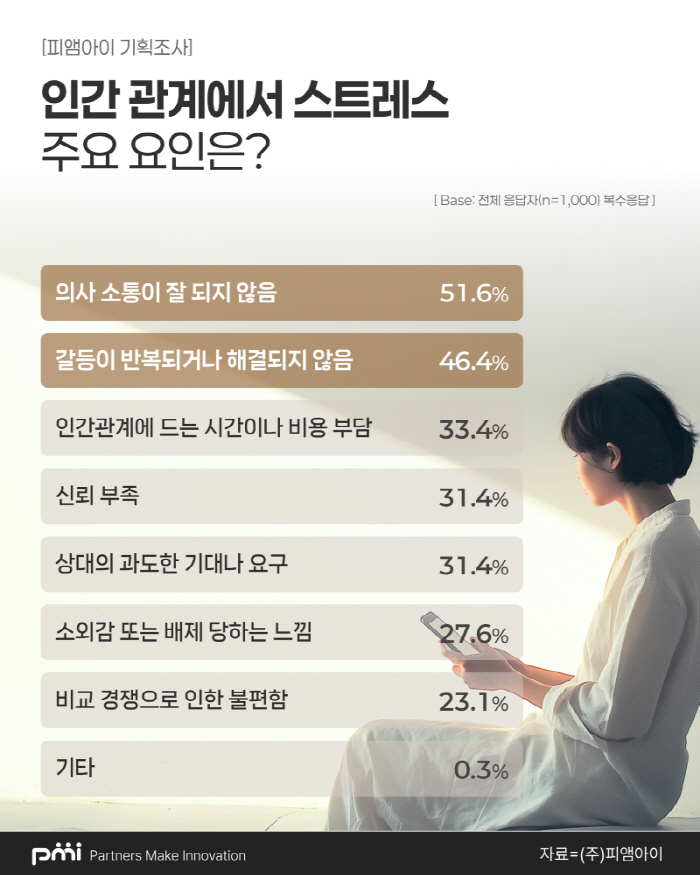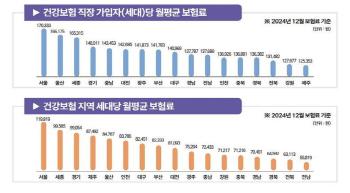No. 1 stress in human relationships is work...in the wake of one's family, acquaintances, etc
Jun 04, 2025
|
The most common target for respondents to experience stress in human relationships was 'work colleagues or bosses'(41.5%). It was followed by ▲'Family'(19.2%) ▲'Life relationship such as neighbors and acquaintances'(16.8%), ▲'Friend'(10.1%) ▲'Lover or spouse'(6.6%) ▲'Online community and SNS relations'(5.7%). By age, the percentage of respondents in their 20s said they felt stressed in various relationships such as friends, family, and SNS relationships in addition to work, while those in their 50s had relatively high stress in the relationship between work and living acquaintances.
Major causes of stress in human relationships are ▲'communication difficulty'(51.6 percent, duplicate selection) ▲'conflict repeated or not resolved'(46.4 percent) ▲'burden of time or cost for maintaining human relationships'(33.4 percent) ▲'Lack of trust'(31.4 percent) ▲'Excessive expectations or demands of others'(31.4 percent) ▲'Feeling alienated or excluded'(27.6 percent) ▲'Unconvenience due to comparison and competition'(23.1 percent).
The most common situations in human relationships were ▲'when misunderstood or distorted evaluation'(38.4%), followed by ▲'when personal time and space are violated'(29.2%), ▲'When you have to attend social events such as meetings and dinners'(16.0%), ▲'Request excessive emotional intimacy'(11.6%) ▲'Forcing messenger or SNS response'(4.9%). In particular, those in their 20s responded that privacy infringement and social attendance were burdensome, while those in their 50s had high stress from the evaluation of others.
As a way to deal with human relations conflicts, ▲'You naturally move away from the distance'(37.0%) ▲'I endure alone'(28.4%) ▲'You try to have a direct conversation to resolve itIt was followed by '(16.8%) ▲'Consult or seek advice from people around you'(10.4%) ▲'Break the relationship'(7.3%). The most difficult point in a conflict situation was the pressure to force the relationship to be maintained'(33.7%), followed by ▲'Emotional hurt'(27.4%) ▲'(16.1%) ▲'Confused not knowing how to deal with it'(12.5%) ▲' Peripheral gaze or reputation'(10.2%).
As for the way we currently maintain human relationships, 'We try to maintain minimal relationshipsThe response to ' was the highest at 36.7%, followed by ▲'I care to some extent'(32.6%) ▲'I don't manage it particularly'(19.2%) ▲'I tend to actively manage and maintain it'(11.5%). As for the direction of human relations management in the future, 'I want to organize only necessary relationships'(38.6%) responded the most, and ▲'I want to live without caring about the relationship itself'(27.1%) ▲'I want to maintain it as it is nowIt appeared in order of '(23.4%) ▲'I want to expand new human relationships further'(10.8%). In addition, as for the social atmosphere, the most common response was that 'the culture of boldly organizing unnecessary relationships has become stronger'(39.5%), followed by ▲'the criteria for human relations have diversified'(35.2%) ▲'I don't know'(14.7%) ▲'It is still important to maintain all relationships'(10.6%).
An official of PAMI Co., Ltd. said, "The results of this survey show that not a few people experience emotional exhaustion in various social relationships."Recently, there is a growing tendency to perceive human relationships as objects of choice and management, not objects of maintenance." he said.
|
This article was translated by Naver AI translator.















